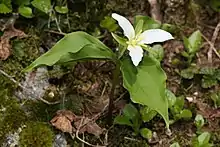Trilliaceae
Trilliaceae was the botanical name of a family of flowering plants. The family has been recognised as distinct since 1846 when it was recognized; this table for a summarizes the placement of these taxa. The family has been recognized by taxonomists such as Takhtajan, Dahlgren, Thorne, and Watson & Dallwitz; other taxonomists have considered these plants to belong to the family Liliaceae. The APG IV system, of 2016 (unchanged from the APG system, of 1998), does not recognize such a family either and assigns the plants involved to family Melanthiaceae, tribe Parideae. One problem with this recognition is the lack of morphological synapomorphies for the family Melanthiaceae; this chart provides a summary of the characters in each of the major groups.
Nevertheless, some taxonomists still recognize a separate family Trilliaceae. The most important genus in North America is Trillium, and the taxonomy of that genus has always been controversial. To paraphrase what Steven Elliott wrote of the genus Trillium in 1817,
- "this family is an interesting one. A whorl of leaves at the summit of a stem, supporting a single flower, it contains and conceals many species."
A recent treatment (Farmer and Schilling 2002) stated that the family Trilliaceae, which exhibits an arcto-tertiary distribution, comprises six genera. Three of these exhibit a wide distribution:
- Paris from Iceland to Japan,
- Daiswa from eastern Asia, and
- Trillium from North America and eastern Asia
Three are monotypic, endemic genera:
- Trillidium govanianum, with a tepaloid inflorescence, from the Himalayan Mountains;
- Kinugasa japonica, with petaloid sepals, from Japan; and
- Pseudotrillium rivale, newly segregated, with spotted petals, from the Siskiyou Mountains of California and Oregon.
Within Melanthiaceae, these are consolidated into three genera;
- Parideae
- Paris L. (including Daiswa and Kinugasa)
- Pseudotrillium S.B.Farmer
- Trillium L. (including Trillidium)
 Paris quadrifolia in flower
Paris quadrifolia in flower.jpg.webp) Paris quadrifolia in fruit
Paris quadrifolia in fruit Paris quadrifolia from Sturm (1796)
Paris quadrifolia from Sturm (1796) Trillium grandiflorum
Trillium grandiflorum Trillium luteum
Trillium luteum Trillium luteum
Trillium luteum Trillium ovatum
Trillium ovatum Trillium tschonoskii
Trillium tschonoskii
External links
- Susan Farmer's web pages on Trilliaceae and the genus Trillium
- Farmer & Schilling 2002 -- article in Systematic Botany on Trilliaceae
- Trilliaceae in L. Watson and M.J. Dallwitz (1992 onwards). The families of flowering plants: descriptions, illustrations, identification, information retrieval. Version: 3 May 2006. http://delta-intkey.com.
- links at CSDL, Texas
- history and placement of taxa in Trilliaceae
- morphological characters of genera within Melanthiaceae sensu APG II
